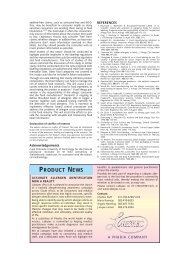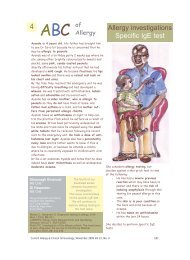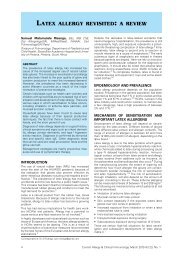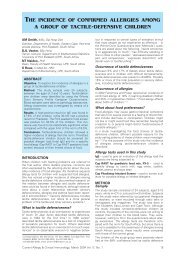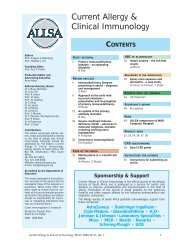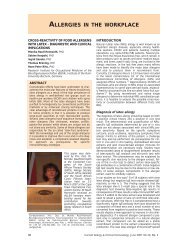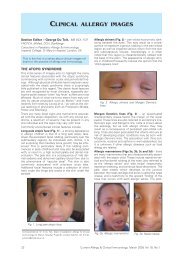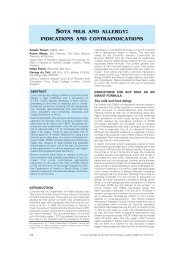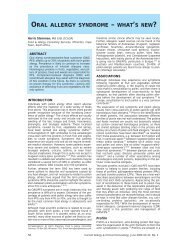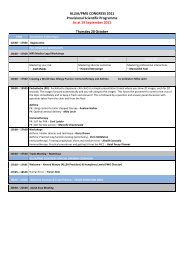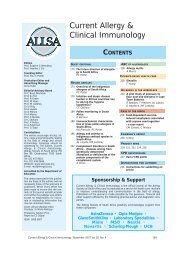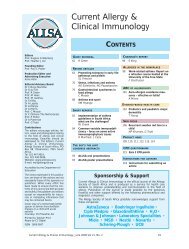The atopic march
The atopic march
The atopic march
You also want an ePaper? Increase the reach of your titles
YUMPU automatically turns print PDFs into web optimized ePapers that Google loves.
THE ATOPIC MARCHEugene G Weinberg, MB ChB, FCPaedAllergy Diagnostic and Clinical Research Unit, UCTLung Institute, Observatory, South AfricaABSTRACT<strong>The</strong> <strong>atopic</strong> <strong>march</strong> refers to the natural history ofallergic or <strong>atopic</strong> manifestations characterised by atypical sequence of clinical symptoms and conditionsappearing during a certain age period and persistingover a number of years. In general the clinicalfeatures of <strong>atopic</strong> eczema occur first and precedethe development of asthma and allergic rhinitis.This article outlines a number of studies that havedemonstrated the <strong>atopic</strong> <strong>march</strong> in infants and youngchildren. Early markers are noted and preventionmethods outlined.<strong>The</strong> <strong>atopic</strong> <strong>march</strong> is better known as the ‘allergic<strong>march</strong>’ in South Africa. This latter term is also betterunderstood by parents and patients when used duringexplanation at consultations in allergy practice.However most international publications now use theterm the ‘<strong>atopic</strong> <strong>march</strong>’.Atopic diseases such as asthma, allergic rhinitis andeczema are allergic conditions that tend to occur infamilies and are associated with the production of specificIgE antibodies to common food and environmentalallergens.<strong>The</strong> <strong>atopic</strong> <strong>march</strong> refers to the natural history of allergicor <strong>atopic</strong> manifestations characterised by a typicalsequence of clinical symptoms and conditions appearingduring a certain age period and persisting over anumber of years. Characteristic of the clinical signs isthat some features become more prominent with timewhereas others diminish or disappear completely. 1 Ingeneral the clinical features of <strong>atopic</strong> eczema occur firstand precede the development of asthma and allergicrhinitis (Fig. 1).Fig. 1. Incidence of <strong>atopic</strong> disease in early childhood.Several studies have demonstrated the <strong>atopic</strong> <strong>march</strong>from <strong>atopic</strong> eczema to the development of asthma andallergic rhinitis. In the UK Rhodes et al. 2 studied 100infants from <strong>atopic</strong> families over a 22-year period. <strong>The</strong>Correspondence: Prof EG Weinberg, Allergy Diagnostic and ClinicalResearch Unit, UCT Lung Institute, PO Box 34560, Observatory 7925.Tel 021-406-6889, fax 021-406-6888, e-mail: weinberg@yebo.co.zaprevalence of <strong>atopic</strong> eczema reached a peak in 20% ofchildren at 1 year of age and then declined to just under5% at the end of the study. <strong>The</strong> prevalence of allergicrhinitis increased from 3% to 15% over the study period.Parent-reported wheezing increased from 5% duringthe first year of life to 40% of the study group at 22years of age. Sensitisation to allergens as determinedby skin-prick tests to 6 common allergens (D.pteronyssinus, mixed grasses, dog, cat, egg, milk)increased to a peak of 36% at 22 years of age. <strong>The</strong>major risk factor for adult asthma was early sensitisationto either foods in the first year of life or aeroallergensin the first 2 years of life.A recent study in Germany 3 has thrown further light onthe <strong>atopic</strong> <strong>march</strong>. <strong>The</strong> large Multicentre Atopy Study(MAS) demonstrated the features of the <strong>atopic</strong> <strong>march</strong>in 1 314 children over a 7-year study period. A high-riskgroup comprising 38% of the children was identifiedwhere at least two family members had <strong>atopic</strong> diseasesor a cord-blood IgE greater than 0.9 kU/l waspresent at birth. In this group 69% of infants who haddeveloped <strong>atopic</strong> eczema by 3 months of age weresensitised to aeroallergens by the age of 5 years. <strong>The</strong>rate of aeroallergen sensitisation increased to 77% inall high-risk children. At 5 years, 50% of children withearly <strong>atopic</strong> eczema and a positive family history ofallergy had developed asthma or rhinitis compared withonly 12% of children without eczema or a positive familyhistory of allergy.THE RELATIONSHIP BETWEEN ATOPICDERMATITIS AND OTHER ALLERGICDISORDERSDohi et al. 4 studied 8 patients with asthma without<strong>atopic</strong> eczema and 8 patients with <strong>atopic</strong> eczema withoutasthma for house-dust mite sensitisation. Bothgroups had inhalation challenges to acetylcholine, anon-specific bronchodilator, and to house-dust mites.Both groups showed airway hypersensitivity to mitesand the response of the <strong>atopic</strong> eczema patients toacetylcholine ranged from normal to the asthmaticrange. <strong>The</strong>se findings suggest that patients with skinsensitisation to house-dust mites can develop airwaysensitisation to the same allergen.Skin sensitisation evokes a systemic allergic responseinvolving the upper and lower airways. Evidence thatskin sensitisation can lead to airway sensitisationcomes from an experimental study in a mouse modelof allergy. Spergel et al. 5 applied ovalbumin to thestripped skin of mice in order to induce dermatitis andspecific IgE production. This group of mice was comparedwith a group where only saline was applied. <strong>The</strong>ovalbumin sensitised mice showed marked epidermalinfiltration of CD3+T cells and eosinophils. Increases inthe expression of both T-helper 2 (TH2) and TH1cytokines (interleukin 4 (IL-4), IL-5 and interferongamma(IFN-γ) were noted consistent with the increaseof these cytokines in <strong>atopic</strong> eczema. <strong>The</strong> sensitisedmice were subsequently challenged with a single exposureto inhaled ovalbumin and bronchoalveolar lavage(BAL) fluid was examined. <strong>The</strong> treated mice showed asignificant increase in eosinophils in the BAL fluid comparedwith saline-sensitised mice. <strong>The</strong> ovalbumin mice4 Current Allergy & Clinical Immunology, March 2005 Vol 18, No.1
were later shown to have a tenfold greater sensitivityto methacholine than the saline group. Thus the typicalairway hyperresponsiveness associated with asthmafollowed cutaneous sensitisation in this group of mice.IgE-mediated allergic reactions are largely regulated byT-lymphocytes. Two types of T- helper lymphocyteshave been identified, TH1 and TH2 cells.It is generally accepted that the increased prevalenceof allergic diseases during recent years is due to a disturbedTH1-TH2 balance leading to greater expressionof the TH2 features resulting from the secretion of thecytokines IL-4, IL-5,IL-10 and IL-14. <strong>The</strong>se cytokinesare able to induce IgE production and to activateeosinophils leading to allergic inflammation. <strong>The</strong> exactreasons for the skewing of the TH1-TH2 balancetowards the TH2 profile in allergic individuals isunknown but has been attributed to a Westernlifestyle.Decreased postnatal microbial stimulation results in anincreased possibility of ongoing postnatal TH2 reactions.Modern lifestyle resulting in decreased bacterialstimulation (improvements in public health, reduction infamily size with fewer infectious contacts and the earlyuse of antibiotics) can more easily lead to this situation.This is the so-called ‘hygiene hypothesis’ which is thesubject of much current interest.EARLY MARKERS OF INCREASED RISKFOR ALLERGIC DISEASEA number of earlymarkers for atopyindicating anincreased risk forthe developmentof subsequentallergy have beenidentified. <strong>The</strong>seinclude an elevatedcord-blood IgElevel (high specificitybut low sensitivity),a positiveskin-prick test toegg (Fig. 2) orhouse - dust mitein the first year oflife and the detectionof specific IgEto common foodsand inhalant allergensduring earlyinfancy. 6Fig. 2. Positive skin-prick testto egg.PREVENTION OF ATOPYPrimary prevention measures for <strong>atopic</strong> diseasesinvolve the avoidance of early allergen exposure to certainfoods and inhalants. <strong>The</strong>se measures must beintroduced from birth to be successful. Breastfeedingis recommended in spite of evidence that allergenicfood fractions such as eggs and peanut will appear inbreast milk if consumed by the mother. Breastfeedingappears to delay or prevent the occurrence of cows’milk allergy but hypo-allergenic diets for breastfeedingmothers only seem to be of value for infants alreadymanifesting obvious allergic symptoms. 7Delayed introduction (>age of 6 months ) of solid foodsseems to be advisable in <strong>atopic</strong> infants and eggs shouldbe avoided in infants already presenting with <strong>atopic</strong>eczema. 8Infants with <strong>atopic</strong> dermatitis should be a target groupfor the prevention of asthma. Several studies haveinvolved the early use of antihistamines in children with<strong>atopic</strong> eczema as a measure to reduce the risk of developingasthma and allergic rhinitis.In the first of these trials Iikura et al. 9 treated 121 childrenwith <strong>atopic</strong> eczema (aged 1-36 months) witheither ketotifen or placebo before the onset of asthma.After 1 year of study significantly fewer patients in theketotifen group had developed asthma compared withthe placebo group.<strong>The</strong> ETAC (Early Treatment of the Atopic Child) study 10examined the role of cetirizine in delaying the <strong>atopic</strong><strong>march</strong>. This was a prospective, randomised, doubleblindparallel group and placebo-controlled study of 817infants of 1-2 years of age. <strong>The</strong> infants had <strong>atopic</strong>eczema and a family history of atopy. <strong>The</strong> treatmentduration was 2 years and total and specific IgE weremeasured at baseline and at regular intervals throughoutthe study period. <strong>The</strong> infants were treated withhigh-dose cetirizine or placebo. At the end of the study40% of the infants had developed asthma. Childrenwith early sensitisation to egg, milk, cat, grass or housedust had an increased risk for asthma. <strong>The</strong> studyshowed no significant difference between the cetirizineand the placebo-treated groups for the the developmentof asthma.However, the number of patients with house-dust mitesensitisation who developed asthma dropped from51% in the placebo group to 28.6% in the cetirizinegroup.Also 58% of children with grass sensitisation in theplacebo group developed asthma while only 27.8% ofthe cetirizine group developed asthma. Although thisstudy appears promising, more long-term informationis required focusing specifically on allergic children. Asecond large (ETAC) study using cetirizine is currentlyunder way and the results should be most informative.In the future it is anticipated that therapies that modifythe severity of <strong>atopic</strong> eczema in infants and young childrenwill decrease the risk for the eventual developmentof asthma and thus prevent the consequences ofthe <strong>atopic</strong> <strong>march</strong>.REFERENCES1. Spergel JM, Paller AS. Atopic dermatitis and the <strong>atopic</strong> <strong>march</strong>.J Allergy Clin Immunol 2003; 112 S: 118-127.2. Rhodes HL, Sporik R, Thomas P, Holgate ST, Cogswell JJ. Early liferisk factors for adult asthma: a birth cohort study of subjects at risk.J Allergy Clin Immunol 2001; 108: 720-725.3. Lan S, Nickel R, Niggemann B, Gruber C, Sommerfeld C, Illi S. <strong>The</strong>development of childhood asthma: lessons from the GermanMulticentre Allergy Study (MAS). Paediatr Respir Rev 2002; 3: 265-272.4. Dohi M, Okudaira H, Sugiyama H, Tsurumachi K, Suko M, NakagawaT. Bronchial responsiveness to mite allergen in <strong>atopic</strong> dermatitiswithout asthma.Int Arch Allergy Immunol 1990; 92: 138-142.5. Spergel JM, Mizoguchi E, Brewer JP, Martin TR, Bhan AK, GehaRS. Epicutaneous sensitization with protein antigen induceslocalised allergic dermatitis and hyperresponsiveness to methacholineafter single dose exposure to aerosolized antigen in mice.J Clin Invest 1998; 101: 1614-1622.6. Kjellman NIM, Croner S. Cord blood IgE determination for allergyprediction - a follow-up to seven years of age in 1651 children. AnnAllergy 1984; 53: 167-171.7. Herrmann ME, Dannemann A, Gruters A, Radisch B, DudenhausenJW. Prospective study on the atopy preventive effect of maternalavoidance of milk and eggs during pregnancy and lactation. Eur JPediatr 1996; 155: 770-774.8. Fergussen D, Horwood L, Shannon F. Early solid feeding and recurrentchildhood eczema, a 10 year longitudinal study. Pediatrics1990; 86: 541-546.9. Iikura Y, Naspitz CK, Mikawa H, Talaricoficho S, Baba M, Sole D.Prevention of asthma by ketotifen in infants with <strong>atopic</strong> dermatitis.Ann Allergy 1992; 68: 233-236.10. Warner JO. A double-blind randomised, placebo controlled trial ofcetirizine in preventing the onset of asthma in children with <strong>atopic</strong>dermatitis: 18 months treatment and 18 months post-treatmentfollow up. J Allergy Clin Immunol 2001; 108; 929-937.Current Allergy & Clinical Immunology, March 2005 Vol 18, No. 1 5



